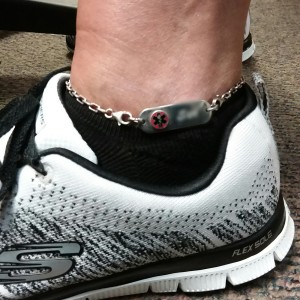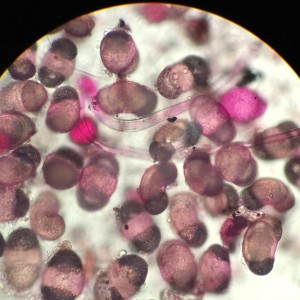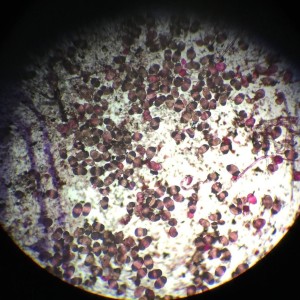Uncategorized

July 14, 2016. Ready-Set-Go: Travel Tips for Allergies & Asthma
For interviews and tours of the Delaware Valley’s only certified pollen and mold spore stations for the National Allergy Bureau (NAB) with stations, please email gwoodlyn@asthmacenter.com
Summer is a special time for making memories.
You may be planning:
- a daytrip (down the shore or to visit one of the Delaware Valley’s many attractions, museums, music or sports venues, or any of our many parks and recreational areas),
- a weekend getaway
- a family vacation or reunion
- a road trip across the U.S. (or to a particular landmark or region)
- a longer trip abroad
- a “bucketlist” cruise or adventure
While some detours can add to the fun, flare ups in allergies, asthma, and sinus problems are not.
The Asthma Center has created the following checklists to help you and your family enjoy healthy and safe outings, travel, and vacations!
Click here for PDF version to save and use for your next adventure
Before you go:
- Visit your specialist. The physicians & staff of The Asthma Center can help you get ready by reviewing your personal Action Plan & special travel needs. For example, individuals with asthma may be unaware that nebulizers are available in extremely small, lightweight, battery-operated, & tubeless units such as the Omron MicroAir nebulizer. We can help you find the unit that’s right for you.
- Prepare a list of current medical conditions (including food & medication allergies) & medications.
- Prepare & pack sufficient quantities of prescription & over-the-counter medications including all back up medi-cations. Check expiration dates.
- Research accommodations. AllerPassMD (edited & analyzed by a board certified allergist provides listings and ratings for hotel rooms & staterooms) is one resource providing ratings on Indoor & Outdoor Allergens as well as Contactants (hair & body products.) Request smoke free rooms with air filters & dust mite proof bedding when booking your lodging.
- Research restaurants. Find food allergy aware restaurants using SafeFare (created by Food Allergy Research & Education (FARE))
- Research your vacation location regarding, air quality & environment, language, nearest medical facility, and pharmacy locations.
- Check your insurance policy regarding coverage and if applicable, purchase and review extra travel medical benefits.
- For those with severe allergy/anaphylaxis, consider purchasing an Allergy Medic Alert Bracelet. When engrav-ing, be as specific as possible in identifying your allergies.
During your trip:
- Carry your list of conditions, medications, and emergency medications everywhere you go.
- Avoid tobacco smoke exposure and always ask for smoke-free hotel room with air filter and dust mite proof bedding
- Use hand sanitizer and wash your hands frequently
- Know the closest emergency services or hospital locations
After Your Trip
- Visit your specialist for follow-up care if you experienced any allergic reactions, asthma flares, and/or anaphylaxis while traveling and if necessary make adjustments to your Action Plan.
- When unpacking, ensure you returned home with all your medications and refill medications as needed.
- Note what was successful and/or unsuccessful on this trip regarding your asthma, allergies and/or sinus problems. If applicable, write online review of restaurants and/or hotel accommodations to share your experiences with others who have allergies and asthma.
Traveling with Epinephrine (EpiPen)
- Visit your specialist if you require special documentation and to review your personal Action Plan
- When flying, request that your epinephrine be visually inspected, not scanned

- Always carry your epinephrine (do not pack in luggage which will be checked handled by others)
- Check the effective date of your epinephrine.
- Know the closest emergency services or hospital locations
▪ For more tips on traveling, visit https://www.epipen.com/have-a-plan/traveling.
Make an appointment to see an allergist – Why Choose Us?
The best way to fight your allergies & asthma is to visit a board certified allergist, learn what your allergies are, create a treatment plan, and adjust as needed. No two allergy & asthma sufferers are alike, so don’t rely on over the counter medications when you could be targeting your symptoms with the help of our allergy experts! At The Asthma Center, we know that no two individuals are alike, and our goal is to personalize your treatment to help you find relief. One way we accomplish this through identifying your allergies and specific levels of allergic sensitivity through allergy skin testing to help you plan your treatment. By following the local pollen counts, we are able to customize allergy regimens that prevent symptoms caused by taking too little, or too much allergy medication.
Did You Know – Pollen & Mold Spore Counts Direct to Your Inbox!
The Asthma Center’s daily Pollen and Mold Spore Count, the Delaware Valley’s only Official count station which is certified by the National Allergy Bureau are now available via email. Subscribe to receive our daily counts by email or check out some of our other blog posts to learn more about what is in the air, how it can affect you, and what you can do about it.
More Info

July 6, 2016. Air Quality Alert: Molds, Weeds & Excessive Heat
For interviews and tours of the Delaware Valley’s only certified pollen and mold spore stations for the National Allergy Bureau (NAB) with stations, please email gwoodlyn@asthmacenter.com
“Today may be the first day of a heat wave for the Delaware Valley, but Outdoor Mold Spore levels have been extreme for almost a week,” reports Dr. Dvorin.
Outdoor mold spores today are over 9600 spores per cubic meter of air/24 period. (Counts above 7000 are extreme and may provoke severe symptoms– see How We Count Pollen.)
“There has been an ebb and flow with the molds aspergillus-penicillium. Today these molds are elevated again well beyond what I have observed as the norm for our area.” warns Dr. Dvorin.
Typically, aspergillus-penicillium counts are under 100 mold spores per cubic meter of air/24 period. Today, aspergillus-penicillium counts are again over 1050 mold spores per cubic meter of air/24 period. For more on mold allergy and the significance of aspergillus-penicillium mold spores in our local air samples, read our recent blog Tales from the Microscope: Unusual Mold Alert.
Historical Prospective
After counting today’s air samples, Dr. Dvorin reviewed the peaks for Outdoor Mold Spores for Delaware Valley for the last 6 years (2010 through 2015.) Conventionally, outdoor mold spores are considered to be higher in the early fall months. Four out of the six years (2010, 2011, 2014 & 2015) support this with peak counts (ranging from nearly 9000 to over 16000 mold spores per cubic meter of air/24 period) noted on days from early September through early October. In 2013, a peak count nearly 19000 was recorded in late May, and in 2012, a count of nearly 14000 was observed in mid-July. It is too soon to say that Outdoor Mold Spore levels are peaking; however, levels are consistently in the ranges seen as some of the peak days in the past six seasons of historical data.
Special Note for those with Allergies & Asthma: In addition to the National Weather Service’s Excessive Heat Warnings for our region (which are in effect now through 6:00pm on Friday 7/8/2016, there Air Quality Alerts have been issued for Philadelphia and Camden Counties.
Today’s count:
Tree pollen and grass pollen are very low.
Weed pollen is moderate. A greater variety of weed pollen is present with Plantago (English Plantain), Rumex (Sorrel & Dock weeds), and Typha (Cattail) all observed.
Outdoor Mold Spores are extreme. Cladosporium molds are approximately 45% of the outdoor mold spores in our local air today.
Predominant: Outdoor Mold Spores & Weed Pollen
Now is the Time
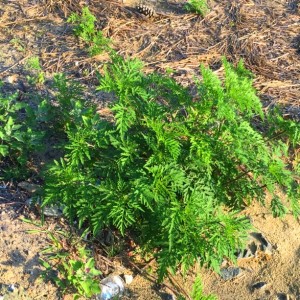
With the traditional onset of Ragweed Pollen Allergy season only a few weeks away and other weed pollen already present at moderate levels, now is the time to get ready! Ragweed is known to be a major allergen across the United States, and particularly so here in the Delaware Valley. However, there are a variety of other weeds that pollinate earlier than ragweed which may provoke symptoms. Pollen from weeds like English Plantain, Sorrel & Dock Weeds and Cattails are present at moderate levels in the Delaware Valley today. If you (or someone you love) typically has allergy, asthma, and/or sinus symptoms in the fall months, now is the time to identify your allergic sensitivity and prepare your treatment plan.
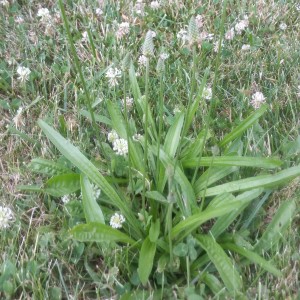
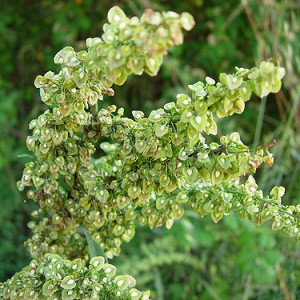
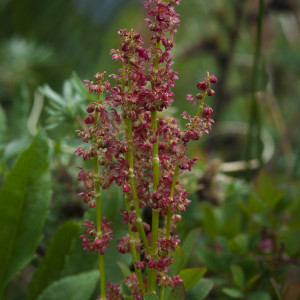
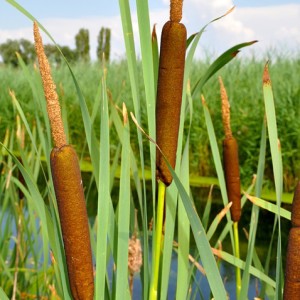
Clockwise starting from the top left: Plantago (English Plantain), Rumes crispus (Curly Dock), Typha (Cattail), & Rumex acetosa (Sheep Sorrel)
At The Asthma Center, our goal is to personalize your treatment to help you find relief. We accomplish this through identifying your allergies and specific levels of allergic sensitivity through allergy skin testing including testing for ragweed and other weed pollen (English Plantain, Pigweed, Cocklebur, Sheep Sorrel, Lamb’s Quarters, Yellow Dock, and Sagebrush). By following the local pollen counts, we are able to customize allergy regimens that prevent symptoms caused by taking too little, or too much allergy medication.
Make an appointment to see an allergist – Why Choose Us?
The best way to fight your allergies is to visit a board certified allergist, learn what your allergies are, create a treatment plan, and adjust as needed. No two allergy sufferers are alike, so don’t rely on over the counter medications when you could be targeting your symptoms with the help of our allergy experts! At The Asthma Center, we know that no two individuals are alike, and our goal is to personalize your treatment to help you find relief. We accomplish this through identifying your allergies and specific levels of allergic sensitivity through allergy skin testing to help you plan your treatment. By following the local pollen counts, we are able to customize allergy regimens that prevent symptoms caused by taking too little, or too much allergy medication.
Did You Know – Pollen & Mold Spore Counts Direct to Your Inbox!
The Asthma Center’s daily Pollen and Mold Spore Count, the Delaware Valley’s only Official count station which is certified by the National Allergy Bureau are now available via email. Subscribe to receive our daily counts by email or check out some of our other blog posts to learn more about what is in the air, how it can affect you, and what you can do about it.
More Info
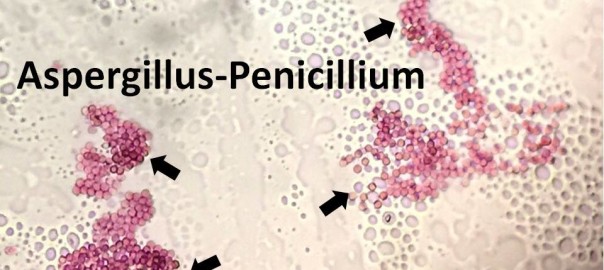
June 21, 2016. Tales from the Microscope: Unusual Mold Alert
For interviews and tours of the Delaware Valley’s only certified pollen and mold spore stations for the National Allergy Bureau (NAB) with stations, please email gwoodlyn@asthmacenter.com
“I see a few of these every day, but today’s aspergillus-penicillium is unusual which may be related to increased humidity in our region.”
That’s the word from Dr. Dvorin after counting today’s air sample. Typically, aspergillus-penicillium counts are under 100 mold spores per cubic meter of air/24 period. Today, aspergillus-penicillium counts are over 1400 mold spores per cubic meter of air/24 period.
Today’s count:
Tree pollen and grass pollen are moderate.
Weed pollen has increased and is high. English Plantain is the predominant weed pollen, and according to Dr. Dvorin, this plant is blooming all over our region.
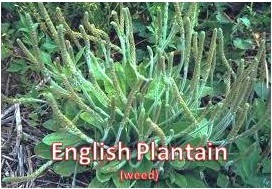
Outdoor Mold Spores are very high. In addition to the highly irregular concentration of aspergillus-penicillium molds, cladosporium molds are also at elevated levels.
Predominant: Outdoor Mold Spores & Weed Pollen
Mold Allergy
Too small to be seen by the naked eye, mold spores are all around us. While everyone breathes them, individuals with mold allergies may experience the typical symptoms of allergic rhinitis (allergies), also known as hay fever including itching, sneezing, and/or nasal congestion. Exposure to mold spores can also provoke flares of asthma. Chronic sinusitis is also sometimes related to mold spore exposure. Other less common reactions to mold spores include allergic bronchopulmonary aspergillosis (ABPA) and allergic fungal sinusitis (AFS.)
What is ABPA?
Allergic bronchopulmonary aspergillosis (ABPA) is an allergic reaction in the lung to Aspergillus fumigatus. Reactions to this fungus are rare in individuals with normal immune systems. Individuals with asthma or cystic fibrosis are among those most commonly affected by ABPA. If you have asthma, one of the first noticeable symptoms may be a progressive worsening of your asthma symptoms including coughing, wheezing, and shortness of breath. Other allergic conditions which may be present include nasal allergies (allergic rhinitis,) sinusitis, and skin allergies (atopic dermatitis/eczema and urticaria/hives.) Treatment usually includes oral corticosteroids and sometimes oral antifungal treatments. Individuals with ABPA are usually closely followed by their physician.
What is AFS?
Allergic fungal sinusitis is the most common fungal infection associated with chronic sinusitis. This condition often occurs in people with nasal polyps and sinus disease. It is usually resistant to conventional medical and surgical treatments. Tissue within the sinuses is often covered with characteristic thick gel-like discolored mucus filled with allergy cells (eosinophils). This gel is often described as “allergic mucin” and often contains fungal elements when properly stained and examined microscopically. Treatment of allergic fungal sinusitis includes surgery, oral and nasal corticosteroids, allergy injection therapy, leukotriene modifiers, antihistamines and oral decongestants. Unfortunately oral antifungal treatment is usually not effective.

The Asthma Center specialists have tremendous experience in evaluating and treating mold allergy including ABPA and AFS. Our physicians have contributed to published research in respected, peer-reviewed journals. This expertise combined with accurate air sample information allows The Asthma Center specialists to vigorously pursue the cause of an individual’s symptoms, develop a personal treatment plan, and provide comprehensive care in both common and unusual cases where mold allergy plays a role in allergy, sinus, and asthma symptoms.
Make an appointment to see an allergist – Why Choose Us?
The best way to fight your allergies is to visit a board certified allergist, learn what your allergies are, create a treatment plan, and adjust as needed. No two allergy sufferers are alike, so don’t rely on over the counter medications when you could be targeting your symptoms with the help of our allergy experts! At The Asthma Center, we know that no two individuals are alike, and our goal is to personalize your treatment to help you find relief. We accomplish this through identifying your allergies and specific levels of allergic sensitivity through allergy skin testing to help you plan your treatment. By following the local pollen counts, we are able to customize allergy regimens that prevent symptoms caused by taking too little, or too much allergy medication.
Did You Know – Pollen & Mold Spore Counts Direct to Your Inbox!
The Asthma Center’s daily Pollen and Mold Spore Count, the Delaware Valley’s only Official count station which is certified by the National Allergy Bureau are now available via email. Subscribe to receive our daily counts by email or check out some of our other blog posts to learn more about what is in the air, how it can affect you, and what you can do about it.
More Info

June 16, 2016. Mars Chocolate Issues Peanut Residue Allergy Alert
For interviews and tours of the Delaware Valley’s only certified pollen and mold spore stations for the National Allergy Bureau (NAB) with stations, please email gwoodlyn@asthmacenter.com
Mars Chocolate North America issued a voluntary recall today on varieties of its COMBOS® products due to exposure of low-level peanut residue, according to a release by the U.S. Food and Drug Administration (FDA).
The affected products include COMBOS® Cheddar Cheese Pretzel, COMBOS® Cheddar Cheese Cracker, COMBOS® Pizzeria Pretzel, COMBOS® Sweet and Salty Caramel Pretzel, COMBOS® Pepperoni Cracker, and COMBOS® Buffalo Pretzel. They can be identified by their “best before” date ranging from March, 2017 – April, 2017 on the back of the package.
Mars initiated the recall after its supplier, Grain Craft, recalled certain lots of wheat flours that potentially contain low levels of peanut residue. COMBOS® Brand products may have been produced using the recalled flour. The vast majority of these products were distributed through the United States, with the remaining batches shipped internationally to the Bahamas, Jamaica, Virgin Islands- St Thomas, Antigua, Colombia, Panama, Puerto Rico, Philippines, South Korea, Taiwan, and Singapore.
Currently, there have been no reports of illness related to the recalled products to Mars Chocolate, and no other Mars products are impacted by this recall. Individuals concerned whether their COMBOS® product is one of the affected should consult the 10-digit manufacturing code directly underneath the “best buy” date that includes the code date numbers listed in the FDA news release.
Peanut Allergy
Whether your peanut allergy symptoms are newly developed or have been around for years, The Asthma Center offers individualized treatment plans and comprehensive care.
Peanut is the most common food allergen for individuals over age 4. Interestingly, refined peanut oil free of peanut protein allergens is usually safe for peanut-sensitive individuals to ingest. Although once considered to be a lifelong allergy, recent studies indicate that up to 20 percent of children diagnosed with peanut allergy outgrow it.
Where peanut allergens hide:
- Processed tree nuts may contain peanuts. Mandelonas may be peanuts soaked in almond flavoring.
- Arachis oil is peanut oil.
- African, Chinese, Indonesian, Mexican, Thai, and Vietnamese dishes often contain peanuts or are contaminated with peanuts during the preparation process.
- Foods sold in bakeries and ice cream shops are often in contact with peanuts.
- Many brands of sunflower seeds are produced on equipment shared with peanuts.
- Most experts recommend that peanut-allergic patients avoid tree nuts as an extra precaution, as contamination or dual sensitivity may be an issue.
- Peanuts can be found in many foods and candies, especially chocolate candy.
Treatment
It is often the case that despite the best efforts of avoidance, accidental ingestions occurs so food allergic individuals need to be prepared for treating these reactions. The first step involves an emergency plan in the event of a reaction. This plan must include medications that need to be used, exactly how much to use, and what to do if a reaction progresses. It is possible that a plan be in effect at all times. In regard to children, the school, daycare setting, babysitters, and other caretakers must be familiar with the plan of action as well as the parents. Recognizing the reaction is the next important step. Many patients who experienced food allergy will recognize the early warning symptoms such as itching of the lips, tongue and/or palms, and soles before full-blown systemic symptoms occur. Every effort should be made to identify warning signs after a reaction.
Depending on symptoms, treatment is initially with oral antihistamines like Benadryl or Atarax as well as an injection of epinephrine. Both the parents and child (when possible) should be familiar with the use of epinephrine. This is a self-injectable medication, which should be available at all times. We recommended that epinephrine be available in multiple kits for adults in the home, car, and work environment and/or purse and/or briefcase. For a child, kits should be available in the home, in the car, and in the school environment and/or daycare center. Other medications may also be used during acute attack including oral steroids, inhalers and/or nebulizer for breathing treatments.
In the event of any severe reaction requiring the use of adrenaline and/or respiratory compromise, it is important to go immediately to the emergency room even if the reaction subsides with the initiation of treatment. Symptoms may be lessened by the time you reach the emergency room area but it is prudent not to leave the emergency room until symptoms are completely stabilized. With these steps in mind, food allergies can be dealt with an effective manner.
Make an appointment to see an allergist – Why Choose Us?
The best way to fight your allergies is to visit a board certified allergist, learn what your allergies are, create a treatment plan, and adjust as needed. No two allergy sufferers are alike, so don’t rely on over the counter medications when you could be targeting your symptoms with the help of our allergy experts! At The Asthma Center, we know that no two individuals are alike, and our goal is to personalize your treatment to help you find relief. We accomplish this through identifying your allergies and specific levels of allergic sensitivity through allergy skin testing to help you plan your treatment. By following the local pollen counts, we are able to customize allergy regimens that prevent symptoms caused by taking too little, or too much allergy medication.
Did You Know – Pollen & Mold Spore Counts Direct to Your Inbox!
The Asthma Center’s daily Pollen and Mold Spore Count, the Delaware Valley’s only Official count station which is certified by the National Allergy Bureau are now available via email. Subscribe to receive our daily counts by email or check out some of our other blog posts to learn more about what is in the air, how it can affect you, and what you can do about it.
More Info
June 15, 2016. Bummer-Free Summer: See an Allergist, Make a Plan
For interviews and tours of the Delaware Valley’s only certified pollen and mold spore stations for the National Allergy Bureau (NAB) with stations, please email gwoodlyn@asthmacenter.com
School’s out for the summer in many areas of Pennsylvania and New Jersey. For many children across the state, summer camp is the action plan of the summer and packing a backpack is as much as they need to do to get ready. For children with allergies, asthma, and/or food allergies however, getting camp-ready takes more planning.
While many camps are equipped with action plans and a staff who are trained to accommodate children with allergies, asthma, and/or food allergies, it’s important to understand how these plans relate specifically to your child’s needs. How prepared is your child for a safe and fun experience at summer camp?
Talk to your Allergist
Your allergist is an important ally to have before your child goes to camp. At The Asthma Center, our board-certified physicians meet with parents and children every year looking to go to summer camp, and create appropriate action plans to get them ready before they leave. Parents concerned about the capability of a specific camp in meeting their child’s needs can also consult with our physicians who will offer solutions or appropriate alternatives. In the event of an emergency, one of our allergists is always on call – if your child needs help, a doctor who knows their medical history will be able to assist remotely.
Make an Action Plan
As a parent, you know your child’s allergies, asthma, and/or food allergies better than most. Identifying your child’s allergy, asthma, and/or food allergy triggers and signs to watch for their symptoms are of the utmost importance, and need to be taken into consideration when choosing a camp for your child. A written allergy plan should cover all bases and have instructions in place that the camp would follow in the event of an emergency or accidental exposure to an allergen. The Asthma Center’s board-certified physicians meet with parents every summer to tailor a plan that best meets your child’s needs while they’re away from home. Summer is not the time to take a break from allergy and asthma medication, and our physicians will make sure a plan is in place so your child and their camp don’t forget.
Communicate, Communicate, Communicate
If your child has an allergy, asthma, and/or food allergies that requires specific medication or a Food Allergy Plan, talk to the camp and give them details of your child’s needs. Ask about their specific allergy accommodations, who (and how many) in the camp are trained to administer an EpiPen or other emergency medical care, and how the camp has handled allergy and asthma flares, and food anaphylaxis in the past. Walking through an action plan approved by your allergist with medical staff and camp leaders ensures they understand how best to react in an emergency situation, and allows you as the parent to gauge the preparedness of the camp staff.
Teach your Child
It’s not enough for the camp to have an action plan if your child doesn’t know how to avoid allergy, asthma, and/or food allergy triggers themselves. Talk to your child about their allergies and how they can avoid exposure to an allergen that may make their symptoms flare. A great guide to help kids learn about their allergies and asthma is through the Camping Safe Key offered by the American Academy of Allergy, Asthma & Immunology (AAAAI). If your child’s allergy requires an EpiPen and they are old enough to carry it with them, make sure they understand how to use it – and in what situation.
Encourage them to ask questions if they feel unsure whether their setting will cause a reaction, like eating in the mess hall if they have food allergies or playing in a field if they are allergic to insect stings. An action plan should address all of these questions preemptively, but reassurance by the child may settle their nerve so they can continue to enjoy their camp experience. The Asthma Center’s physicians are on hand to talk to your child and train them and parents on best-practices for being allergy, asthma, and/or food allergy prepared.
Asthma Camps & Camps in the area that provide allergy-friendly accommodations:
New Jersey:
- Camp Merry Heart- Easter Seals (Hackettstown, NJ)
- Camp TAG (The Allergy Gang) (Williamstown, NJ)
Pennsylvania:
- Asthma Camp of the Greater Leigh Valley (Orefield, PA)
- Camp AsthmaCadabra (Scranton, PA)
- Camp Chen-a-Wanda (Thomson, PA)
- Dragonfly Forest Camp (Poconos; Dingmans Ferry, PA)
Delaware:
- Asthma Camp (Newark, DE)
Maryland:
- Camp Superkids (Maryland Line, MD)
Make an appointment to see an allergist – Why Choose Us?
The best way to fight your allergies is to visit a board certified allergist, learn what your allergies are, create a treatment plan, and adjust as needed. No two allergy sufferers are alike, so don’t rely on over the counter medications when you could be targeting your symptoms with the help of our allergy experts! At The Asthma Center, we know that no two individuals are alike, and our goal is to personalize your treatment to help you find relief. We accomplish this through identifying your allergies and specific levels of allergic sensitivity through allergy skin testing to help you plan your treatment. By following the local pollen counts, we are able to customize allergy regimens that prevent symptoms caused by taking too little, or too much allergy medication.
Did You Know – Pollen & Mold Spore Counts Direct to Your Inbox!
The Asthma Center’s daily Pollen and Mold Spore Count, the Delaware Valley’s only Official count station which is certified by the National Allergy Bureau are now available via email. Subscribe to receive our daily counts by email or check out some of our other blog posts to learn more about what is in the air, how it can affect you, and what you can do about it.
More Info
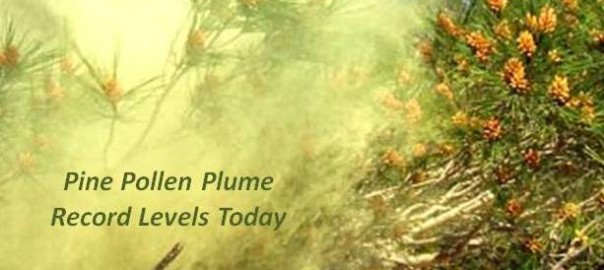
May 31, 2016. Record Pine Pollen: No Holiday for Allergies
For interviews and tours of the Delaware Valley’s only certified pollen and mold spore stations for the National Allergy Bureau (NAB) with stations, please email gwoodlyn@asthmacenter.com
“Pine pollen is extreme today,” says Dr. Dvorin “Sudden hot temperatures, less rain than expected, and more wind—all these weather conditions likely led to today’s surge in Pine pollen, and outdoor mold spores are extreme too!”
Today’s count is the highest Pine Tree Pollen count observed in the Delaware Valley since May, 2012.
Pine Tree Pollen is extreme at nearly 1200 grains per cubic meter of air/24 hours.
Below are two images of Pine Tree Pollen from today’s air sample taken by Dr. Dvorin right from his microscope. The image on the left was taken at a higher power while the image on the right was taken at a lower power.
Pine Pollen Allergy Alert
When you compare today’s images above, especially the higher power image on the left, with the below image which was taken by Dr. Dvorin on 5/19/2016 to illustrate the “Mickey Mouse” appearance of Pine Pollen grains , the difference in volume is dramatic.
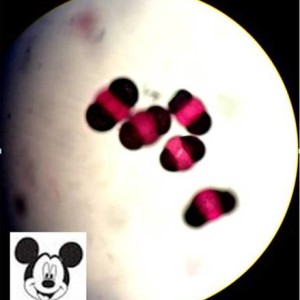
Despite the abundance of pine pollen in our air samples, pine pollen allergy is often ignored.
“For individuals who today are sneezing, itching, have itchy watery eyes and/or other allergy & asthma symptoms, exposure to multiple aeroallergens—what’s in the air—especially pine pollen in our air matters now,” explains Dr. Goldstein. “Pine pollen makes our region unique from an allergy perspective compared to other areas of the Northeastern U.S. where pine pollen is minimal, nonexistent, or other species are prevalent.”
Is Pine Pollen Allergy playing a role in your symptoms?
The Asthma Center routinely tests for pine pollen sensitivity —contact the office location near you to schedule an appointment! For more information on Pine Pollen Allergy, be sure to read our recent blog “Pine: Star Player Triples – Mold Batting Cleanup”
Today’s only official Pollen & Mold Spore Counts for the Delaware Valley:
Overall Tree Pollen Volume and Pine Tree Pollen both increased more than 60% today compared to Friday’s count.
At nearly 1300 pollen grains per cubic meter of air, Tree Pollen is extreme and may provoke severe symptoms. (any count above 1000 is extreme – see How We Count Pollen)
Predominant: Pine Tree Pollen alone is nearly 1200 (also extreme) and today accounts for more than 90% of all tree pollen currently in the air.
Other tree pollen observed in today’s sample include Mulberry, Oak, Walnut, Sweet Gum, Hickory/Pecan, Birch, Ash, & Juniper.
Grass Pollen has remains High. Are you ready? For tips on Grass Pollen Preparedness, read our 5/9 blog Extreme Tree + More Grass & Molds = Misery Monday
Outdoor Mold Spores have nearly around 40% compared to Friday’s count.
At well over 7700 spores per cubic meter of air for 24 hours, Outdoor Mold Spores are extreme and may provoke severe symptoms.
For more on Outdoor Mold Spores and mold allergy, be sure to read our 5/24 blog Rain Brings Trouble As Mold Spores Double
Weed Pollen is moderate. The only weed pollen in the air today is plantago lanceolata (more commonly known as English Plantain.)
For more information on English Plantain, check out the 5/26/2016 pollen blog Pine & Weed Double Header.
If you would like to know if English Plantain weed pollen allergy is playing a role in your symptoms, The Asthma Center does routinely test for pine pollen sensitivity and English Plantain weed pollen sensitivity—contact the office location near you to schedule an appointment!
What Can you do?
Be sure to check back in for The Asthma Center’s daily Pollen and Mold Spore Count, the Delaware Valley’s only Official count station which is certified by the National Allergy Bureau. Subscribe to receive our daily counts by email or check out some of our other blog posts to learn more about what is in the air, how it can affect you, and what you can do about it.
Are you taking too much or too little medication? Are your allergy symptoms (or side effects from too much medication) inferring with your quality of life?
At The Asthma Center, we know that no two individuals are alike, and our goal is to personalize your treatment to help you find relief. We accomplish this through identifying your allergies and specific levels of allergic sensitivity through allergy skin testing to help you plan your treatment.
Once a treatment plan is in place, we work with you to correlate your symptoms by following the local pollen counts. This allows us to customize treatment for your specific situation and therefore prevent and/or treat symptoms by making sure that you know how to adjust your medications up and down and take just the right amount!
Make an appointment to see one of our board certified allergists – Why Choose Us?
The best way to fight your allergies is to visit a board certified allergist, learn what your allergies are, create a treatment plan, and adjust as needed. No two allergy sufferers are alike, so don’t rely on over the counter medications—call a location near you now and be sure to ask about our special Saturday hours!
More Info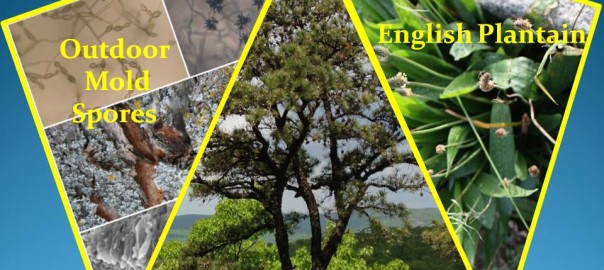
May 27, 2016. Pine Past Prime? Still Playing Hardball
For interviews and tours of the Delaware Valley’s only certified pollen and mold spore stations for the National Allergy Bureau (NAB) with stations, please email gwoodlyn@asthmacenter.com
“It looks like we may be past the peak of Pine,” says Dr. Dvorin “but the heat and humidity are also playing a role in pollen distribution. Outdoor mold spores are still very high, approaching extreme levels, and English Plantain weed pollen. When you consider what’s in the air—Pine Tree Pollen, Outdoor Molds, and Weeds plus the weather variable and the priming effect, the outlook is tough if you have allergies & asthma.”
Today’s only official Pollen & Mold Spore Counts for the Delaware Valley:
Overall Tree Pollen volume and Pine Tree Pollen both decreased an estimated 35% today compared to yesterday. At nearly 600 pollen grains per cubic meter of air, tree pollen remains in the Very High range and may continue to provoke moderate to severe symptoms. As a reminder, tree pollen counts of 1000 and above are considered extreme.
Predominant: Pine Tree Pollen alone is nearly 450 today and once again accounts for 75% of all tree pollen currently in the air.
Despite the abundance of pine pollen in our air samples, pine pollen allergy is often ignored.
“For individuals who today are sneezing, itching, have itchy watery eyes and/or other allergy & asthma symptoms, exposure to multiple aeroallergens—what’s in the air—especially pine pollen in our air matters now,” explains Dr. Goldstein. “Pine pollen makes our region unique from an allergy perspective compared to other areas of the Northeastern U.S. where pine pollen is minimal, nonexistent, or other species are prevalent.”
Curious about what makes Pine a powerhouse hitter in the Delaware Valley? Read yesterday’s post “Pine: Star Player Triples – Mold Batting Cleanup”
Grass Pollen has decreased approximately 30% today but remains High. Are you ready?
For tips on Grass Pollen Preparedness, read our 5/9 blog Extreme Tree + More Grass & Molds = Misery Monday
Outdoor Mold Spores have decreased around 13% compared to yesterday. However, at over 5,000 spores per cubic meter of air for 24 hours, outdoor mold spores are very high and continue to have the potential to provoke moderate to severe symptoms. As a reminder, outdoor mold spore counts of 7000 and above are considered extreme. For more on Outdoor Mold Spores and mold allergy, be sure to read our 5/24 blog Rain Brings Trouble As Mold Spores Double
Weed Pollen is low. The only weed pollen in the air today is plantago lanceolata (more commonly known as English Plantain.) For more information on English Plantain, check out yesterday’s blog Pine & Weed Double Header
If you would like to know if pine pollen allergy or English Plantain weed pollen allergy is playing a role in your symptoms, The Asthma Center does routinely test for pine pollen sensitivity and English Plantain weed pollen sensitivity—contact the office location near to schedule an appointment!
The next Pollen & Mold Spore Count Report will be on Tuesday 5/31/2016.
What’s the Ahead?
The Asthma Center would like to take this time to wish all our friends, patients and staff a Happy Memorial Day! This weekend, we remember the men and women in our armed forces who died fighting for our country and thank them for their service.

If you have allergies, asthma, or sinus problems, there are many things to consider as you plan your weekend. Weather variables will play a role concerning what’s in the air. Another important factor to consider is the “priming effect.” The priming effect is set up during the early periods of exposure to pollen (as in the beginning of tree pollen season). Depending on an individual’s level of allergic sensitivity, symptoms typically are experienced with higher levels of pollen. As the season progresses and exposure to the relevant pollen diminishes, “priming” accounts for why less pollen exposure in the air continues to provoke the same allergic misery.” For more on the priming effect and other Q&A, read Dvorin & Goldstein Field Questions: Pollen & Allergy Misery.
How to Get Relief?
With the temps into the 90s this weekend, it’s more likely than not that most time spent during the day will be outside. While we all know protection from the sun is important, allergy sufferers need to take additional precautions against aeroallergens.
Typically, pollen in the air tends to peak around early-morning, causing symptoms to be at their worst then. However, this year we’ve continuously seen a different trend: pollen has been reaching its peak levels around mid-day. If levels rise this weekend, allergy sufferers could be feeling the effects later in the day. Luckily, there are a few ways to mitigate your worst allergy symptoms. Here are some best-practice tips for keeping your weekend allergy free:
- Wear long sleeves and long pants when mowing the grass.
- Sleep with windows closed and drive with windows up (Don’t miss blog Shut the Door, Seal the Windows )
- Beware of tracking grass pollen into your home (kids, pets especially, newspaper sleeves, and on shorts and jackets)
- Shower and wash your hair after extended outdoor exposure
- Wear sunglasses or glasses outdoors to limit exposure of pollen to your eyes
- Avoid wearing contact lenses, or switch to daily disposable contacts to avoid allergens building up on the lenses
- Wash your hands and face frequently, including eyebrows
- Change your pillowcase often
Allergy-Free Gardening
Allergy-sufferers who like to garden or are looking to buy flowers for the holiday weekend may experience difficulty around flowers and other plants in indoor and outdoor garden environments. Fortunately, many flowers produce very little or no pollen. However, it’s important to recognize the few that can cause misery to allergic individuals. Learn more about allergy-free gardening and indoor houseplants/flowers here.
Grass pollen tips / Does the smell of cut grass bother you?
Mowing your lawn regularly can help cut down on the pollination of grasses on your property. However, many people experience allergy symptoms when exposed to the smell of freshly cut grass. Allergic reactions to mowed grass are more likely from the non-pollen parts of the grass containing allergenic proteins or molds being stirred up in the mowing process. When you mow your lawn, allergen concentration of this type will dramatically increase for a short period of time during and immediately after you mow.
So, mowing your lawn will often be beneficial in the long-term, though it may aggravate your allergies short-term. Reactions to cut grass sometimes can go beyond the spring grass pollination season as well. Again, this is not due to grass pollen but from exposure to mold spores or reactions to other grass antigens in the blades of grass.
Next Pollen and Mold Spore Count: Monday 5/31/2016
Be sure to check back in for The Asthma Center’s daily Pollen and Mold Spore Count, the Delaware Valley’s only Official count station which is certified by the National Allergy Bureau. Subscribe to receive our daily counts by email or check out some of our other blog posts to learn more about what is in the air, how it can affect you, and what you can do about it.
Make an appointment to see an allergist – Why Choose Us?
The best way to fight your allergies is to visit a board certified allergist, learn what your allergies are, create a treatment plan, and adjust as needed. No two allergy sufferers are alike, so don’t rely on over the counter medications when you could be targeting your symptoms with the help of our allergy experts! At The Asthma Center, we know that no two individuals are alike, and our goal is to personalize your treatment to help you find relief. We accomplish this through identifying your allergies and specific levels of allergic sensitivity through allergy skin testing to help you plan your treatment. By following the local pollen counts, we are able to customize allergy regimens that prevent symptoms caused by taking too little, or too much allergy medication.
More Info
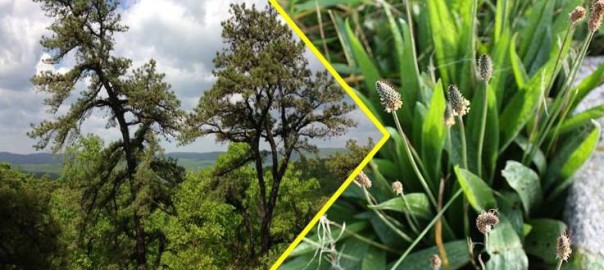
May 26, 2016. Pine & Weed Pollen Double Header
For interviews and tours of the Delaware Valley’s only certified pollen and mold spore stations for the National Allergy Bureau (NAB) with stations, please email gwoodlyn@asthmacenter.com
Today’s only official Pollen & Mold Spore Counts for the Delaware Valley:
Overall Tree Pollen volume increased an estimated 28% today compared to yesterday. At nearly 900 pollen grains per cubic meter of air, tree pollen remains in the Very High range and may continue to provoke moderate to severe symptoms. As a reminder, tree pollen counts 1000 and above are considered extreme.
Pine Tree Pollen is increased slightly compared to yesterday and again is the predominant pollen. Today, pine tree pollen accounts for 75% of all tree pollen currently in the air.
Despite the abundance of pine pollen in our air samples, pine pollen allergy is often ignored.
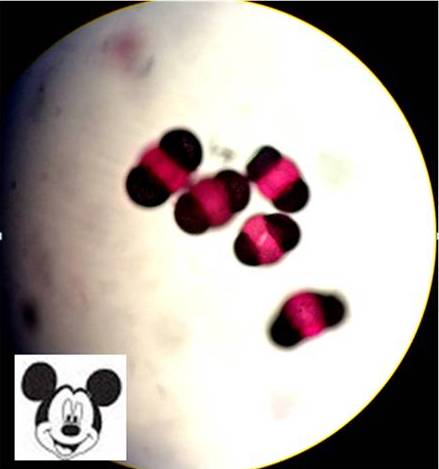
“For individuals who today are sneezing, itching, have itchy watery eyes and/or other allergy & asthma symptoms, exposure to multiple aeroallergens—what’s in the air—especially pine pollen in our air matters now,” explains Dr. Goldstein. “Pine pollen makes our region unique from an allergy perspective compared to other areas of the Northeastern U.S. where pine pollen is minimal, nonexistent, or other species are prevalent.”
Curious about what makes Pine a powerhouse hitter in the Delaware Valley? Read yesterday’s post “Pine: Star Player Triples – Mold Batting Cleanup”
Grass Pollen is increased again today and remain High. Are you ready?
For tips on Grass Pollen Preparedness, read our 5/9 blog Extreme Tree + More Grass & Molds = Misery Monday
Outdoor Mold Spores have decreased approximately 20% compared to yesterday. However, at over 5,600 spores per cubic meter of air for 24 hours, outdoor mold spores are very high and continue to have the potential to provoke moderate to severe symptoms. For more on Outdoor Mold Spores and mold allergy, be sure to read our 5/24 blog Rain Brings Trouble As Mold Spores Double
Weed Pollen is moderate. The only weed pollen in the air today is plantago lanceolata (more commonly known as English Plantain)
There are many kinds of weeds which produce pollen in the Delaware Valley with most typically producing pollen from August through September. However, a few types of weeds produce pollen during the early and midsummer seasons. Plantago lanceolata (commonly known as English Plantain) is one of the “early weeds.”
After finishing today’s counts, Dr. Dvorin reviewed his historical data for English Plantain weed pollen for the last 5 years. “We do see English Plantain at this time of year, in some years,” said Dr. Dvorin. “It [English Plantain] is definitely an early-mid summer pollen for the Delaware Valley with steady volume in June and July, not a big volume pollen usually, but a steady one.
“For English Plantain to be in the moderate range today, this could well be an extra problem for anyone who is also allergic to trees, grasses and or outdoor molds.”
The reason, according to Dr. Dvorin, that having weeds in the moderate range could be an extra problem is due to the priming effect. The priming effect is set up during the early periods of exposure to pollen (as in the beginning of tree pollen season). Depending on an individual’s level of allergic sensitivity, symptoms typically are experienced with higher levels of pollen. As the season progresses and exposure to the relevant pollen diminishes, “priming” accounts for why less pollen exposure in the air continues to provoke the same allergic misery.” For more on the priming effect and other Q&A, read Dvorin & Goldstein Field Questions: Pollen & Allergy Misery.
In the United States, English Plantain is an invasive species. It was likely brought to the Americas as a tea or herbal remedy. Homeowners and landscapers recognize English Plantain as one of the two types of plantain which are troublesome for lawn care. This is because plantain weeds in general thrive in compacted and/or poor soil conditions and takeover quickly if a lawn is neglected. So add weeds to the list of reasons why lawn care is important along with grass pollen!
If you would like to know if pine pollen allergy or English Plantain weed pollen allergy is playing a role in your symptoms, The Asthma Center does routinely test for pine pollen sensitivity and English Plantain weed pollen sensitivity—contact the office location near to schedule an appointment!
Be sure to check back in for The Asthma Center’s Daily Pollen and Mold Spore Count, the Delaware Valley’s ONLY official count station which is certified by the National Allergy Bureau. Subscribe to receive our daily counts by email or check out some of our other blog posts to learn more about what is in the air, how it can affect you, and what you can do about it.
Make an appointment to see an allergist – Why Choose Us?
The best way to fight your allergies is to visit a board certified allergist, learn what your allergies are, create a treatment plan, and adjust as needed. No two allergy sufferers are alike, so don’t rely on over the counter medications when you could be targeting your symptoms with the help of our allergy experts!
More Info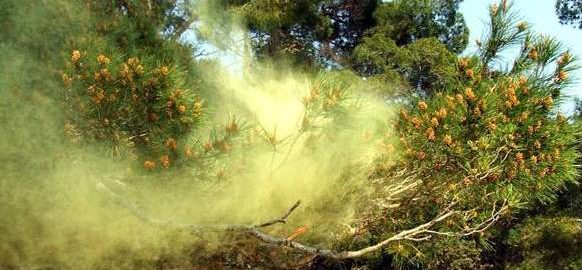
May 25, 2016. Pine: Star Player Triples; Mold Batting Cleanup
For interviews and tours of the Delaware Valley’s only certified pollen and mold spore stations for the National Allergy Bureau (NAB) with stations, please email gwoodlyn@asthmacenter.com
We’ll get to our heavy hitter, Pine Tree Pollen, right after…
Today’s only official Pollen & Mold Spore Counts for the Delaware Valley:
Outdoor Mold Spores have increased to over 7000 spores per cubic meter of air for 24 hours and are extreme with the potential to provoke severe symptoms. For more on Outdoor Mold Spores and mold allergy, be sure to read yesterday’s blog Rain Brings Trouble As Mold Spores Double
Grass Pollen is increased again today and remain High. Are you ready?
For tips on Grass Pollen Preparedness, read our 5/9 blog
Overall Tree Pollen volume more than doubled today compared to yesterday. At nearly 700 pollen grains per cubic meter of air, tree pollen remains in the Very High range and may continue to provoke moderate to severe symptoms.
Pine Pollen Triples compared to yesterday and is the predominant tree pollen player in the air today.
“In our 24 hour air sample, I started seeing more pine pollen grains later in the day—considering that we have sunshine and drier conditions today, expect these numbers to increase,” reports Dr. Dvorin. “We are now in the peak of pine pollen season.”
Pine Pollen Volume Unique to the Delaware Valley
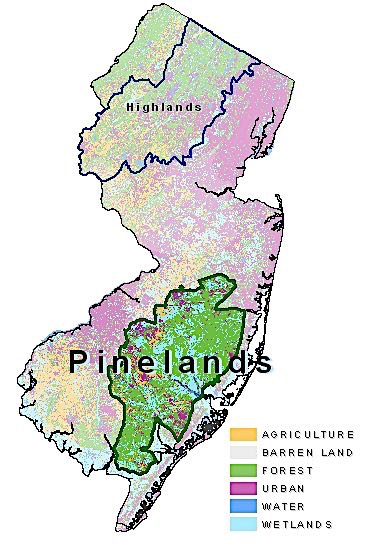
Within the heart of the Delaware Valley sits the 1.1 million acre (see map) protected open space known as the New Jersey Pinelands. Although there are over 110 different species of the pine family (Pinus), this protected area is home to the largest cluster of pitch pine, Pinus rigada (see picture below) on the United States (U.S.) Eastern coastline.
“For individuals who today are sneezing, itching, have itchy watery eyes and/or other allergy & asthma symptoms, exposure to multiple aeroallergens—what’s in the air—especially pine pollen in our air matters now,” explains Dr. Goldstein. “Pine pollen makes our region unique from an allergy perspective compared to other areas of the Northeastern U.S. where pine pollen is minimal, nonexistent, or other species are prevalent.”
Dr. Dvorin, co-founder of The Asthma Center, has been studying the tree pollen seasons in the Delaware Valley each spring for years. From the very beginning, he has observed notable pine pollen levels in both our Southern New Jersey and Philadelphia air samples.
According to Dr. Dvorin, typically pine tree pollen appears in late May through the end of June with extreme peak levels recorded over 1000 pine pollen grains per cubic meter of air/24 hours. This year, however, has not been a typical year. Pine tree pollen made an earlier than usual first appearance in mid-March, not unlike many other tree pollen species in the Delaware Valley this spring. As often noted in our daily counts and pollen blogs, pine pollen has been part of the “big three—Oak, Pine & Mulberry”—which have all been pumping tree pollen into our air and causing misery for allergy sufferers.
“We’re definitely in the height of pine pollen season,” reports Dr. Dvorin.
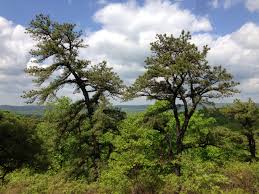
With levels tripling in the last 24 hours, pine tree pollen today is over 300 per cubic meter of air/24 hours and is the predominant tree pollen in the air, contributing nearly 50% of all tree pollen currently in the air.
Despite the abundance of pine pollen in our air samples, pine pollen allergy is often ignored.
Allergists both locally and nationally have for years felt that pine pollen is not a clinically relevant allergen, and many rarely test for pine pollen allergy. Some studies suggest that the prevalence of pine pollen allergy may range from 2%-10% of the population; however, there have been no studies that have firmly established the incidence of pine pollen allergy in the general allergic population.
Because of our region’s proximity to the Pinelands, the board certified Allergists of The Asthma Center continue to clinically recognize allergic symptoms at this time of year can be caused by pine pollen allergy. “We have included pine pollen in our allergy skin testing panel for years because we’re near the Pinelands and we know significant levels of pine pollen can be in the air,” explains Dr. Goldstein. (Read more about The Asthma Center if you are interested in being tested for pine pollen allergy.)

Box Score on Pine Pollen Allergy
Pine pollen grains typically bear a waxy thick coat that surrounds its rather large size (see picture). Pine pollen grains can be 60 to 100 micrometers in diameter. Pine pollen is large compared to other pollen grains (typical pollen grain size is approximately 10 micrometers). The size of pine pollen had been felt to be a reason why pine pollen might not be distributed by wind and through the air. However, studies (and Dr. Dvorin’s own pollen counts) have proven that this not the case. In fact, despite its large size, pine pollen is capable of traveling great distances.
The pine pollen grain typically has 2 large air sacks that give it a “Mickey Mouse” appearance (see picture.) These air sacks reduce the pine pollen grain density and contribute to the pollen’s buoyancy, allowing it to travel long distances in the air. As an example, the center of the Pinelands is about 40 miles from Center City Philadelphia. Yet our urban air samples from our Philadelphia, PA collection station are generally the same relative volume of pine pollen grains as found in our suburban air samples from our Mount Laurel, NJ collection station which is 30 miles from the Pinelands.
Thinking that the size of pine pollen grains were too large to enter the nasal and lung passages, many physicians (including allergists) did not consider pine pollen a relevant allergen. Evidence that it can be inhaled and provoke symptoms are found in cases reported in the medical literature as far back as 1921. Published results from limited investigation of pine pollen allergy have shown that pine pollen allergy does cause allergic responses in the skin (positive allergy skin tests) and allergy responses on nose, eye, and lung challenges.
In addition to the limited reports of pine pollen-induced hay fever or bronchial asthma, there have been reports of allergies to ingested pine nuts (the seeds of pine trees) or from pine nuts found in pesto, sauces, salads, meatballs, cakes, candies and cookies. Interestingly enough, there is very little cross reactivity of pine nuts with other tree nuts. This is due to the fact that, evolutionarily, pine nuts are not from flowers as in the case of other tree nuts (like walnut, hazelnut, cashew, pistachios), but are contained within the pine cone—making them antigenically different from other tree nuts.
Another unusual manifestation of pine pollen sensitivity is in those who have “Xmas tree allergy.” This may be due to pine pollen being released from pine cones when cut trees are hydrated in the home causing nasal, eye, and chest symptoms during the Xmas holiday season.
The board certified Allergists at The Asthma Center are very much aware, therefore of the importance of pine pollen as an important spring allergen. Many patients who previously escaped diagnosis of seasonal pine pollen allergy was due to the fact that allergy skin testing to pine pollen was not performed or was not considered as a clinically significant allergen capable of provoking symptoms. If you would like to know if pine pollen allergy is playing a role in your symptoms, The Asthma Center does routinely test for pine pollen sensitivity—contact the office location near to schedule an appointment!
Be sure to check back in for The Asthma Center’s Daily Pollen and Mold Spore Count, the Delaware Valley’s ONLY official count station which is certified by the National Allergy Bureau. Subscribe to receive our daily counts by email or check out some of our other blog posts to learn more about what is in the air, how it can affect you, and what you can do about it.
Make an appointment to see an allergist – Why Choose Us?
The best way to fight your allergies is to visit a board certified allergist, learn what your allergies are, create a treatment plan, and adjust as needed. No two allergy sufferers are alike, so don’t rely on over the counter medications when you could be targeting your symptoms with the help of our allergy experts!
More Info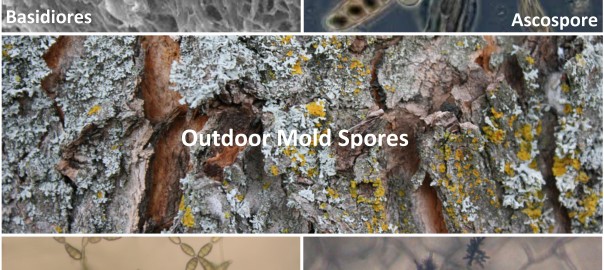
May 24, 2016. Rain Brings Trouble As Mold Spores Double
“Outdoor mold spores more than doubled compared to yesterday, “ reported Dr. Dvorin. “It’s the weather—the storms and the rain—and temperatures heating up.”
In the past 30 days, the National Weather Service (NOAA) recorded more rain for Philadelphia/Mount Holly, NJ than for Seattle, WA!
Rain, lightning, and thunderstorms have all been part of the “unsettled” weather patterns in our region, and Dr. Dvorin has observed quite a “rollercoaster” of volume for pollen and outdoor spore counts, all of which defy the so-called “pollen & mold forecasts” available online and by smartphone app.
Just as weather has played a role in disrupting the pollen process, today’s intensification of outdoor mold spores in the air samples are likely because mold thrives with heat and moisture. Today’s outdoor mold spore counts is over 6000 mold spores per cubic meter air/24 hours which is Very High and may provoke moderate to severe symptoms for those with outdoor mold allergy.
Outdoor Mold Spores – What are they?
Molds, also known as fungi, produce spores and other fungal particles. Our Daily Pollen and Mold Spore Count only tracks outdoor mold spores, not those that may be present in a home. Outdoor mold spores, like pollen, are airborne and become abundant in the warmer weather months. Here in the Delaware Valley, molds appear in the early spring and persist throughout the summer and fall seasons. There is no “peak” in mold spores due to their general prevalence throughout most of the year, but the highest levels are typically observed from midsummer to late fall. During winter months, outdoor mold spores reduce significantly – especially during snow cover.
It is easy to tell the difference between pollen and mold spores under a microscope. However, outdoor mold spores typically have similar appearances and are too small to tell apart. There are several types of molds in the local area: Alternaria, Cladosporium, Basidiospores, Ascospores, Epicoccum.
Tree pollen volume increased approximately 40% compared to yesterday and remains Very High and capable of provoking moderate to severe allergy symptoms.
Predominant Tree Pollens: Oak, Pine & Mulberry
Grasses increased approximately 15% and are High.
Ragweed and other weed pollens are not seen.
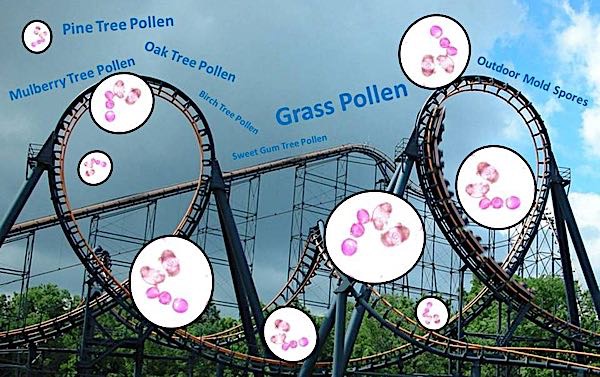
What Steps Can I Take?
Outdoor mold spore symptoms are very similar to other allergy symptoms and often require a similar treatment plan. Grasses are tied to outdoor mold spores in a very specific way. Many people think that the symptoms they experience when mowing their lawns are related to a grass pollen allergy. In reality, the reaction is due to exposure to mold spores released in the air during the mowing as well as other grass antigens.
When mowing your lawn, be sure to:
- Wear long sleeves and long pants when mowing the grass. Be sure to shower & wash your hair afterwards.
- Limit time outdoors during the early morning hours when the most pollen is released
- Sleep with windows closed and drive with windows up (Don’t miss our recent blog Shut the Door, Seal the Windows )
- Beware of tracking grass pollen into your home (kids, pets especially, newspaper sleeves, and on shorts and jackets)
- Shower and wash your hair after extended outdoor exposure
For more information on grass allergies, read: Extreme Tree + More Grass & Molds = Misery Monday
If you find you aren’t having success with managing your allergies on elevated outdoor mold spore days, it may be time to create or reexamine a plan of action with one of The Asthma Center’s Board Certified Allergists. We are still early in the season for outdoor mold spores, so don’t wait until your symptoms are at their worst to Get Relief!
Subscribe
to receive our daily counts by email or check out some of our other blog posts to learn more about what is in the air, how it can affect you, and what you can do about it.
More Info

